Today@Sam Article
Students Share Stories Of Out-Of-This-World Astronomy Experience In Australia, Wyoming
Oct. 23, 2017
SHSU Media Contact: Lane Fortenberry
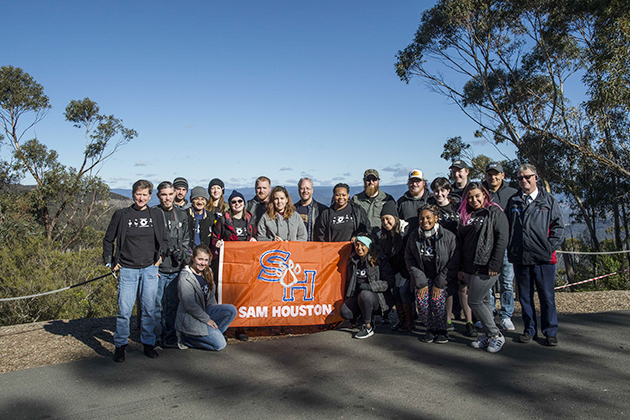 |
| The 2017 Sam Houston State University Bucket List Astronomy Tour Class. (From left) C. Renee James, Jeffery Berg, Jamz Engelking, Gill Rodriguez, Abigail Stephens, Sarah Deitrich, Diane Brewer, Jacob Ackman, Sandy Ackman, Scott Miller, Maya Fitch, Allyah Mohammed, Benjamin Blume, Cristal Hernandez, David Collicott, Rayne Horton, Zoe Pappas, Tyler Coleman, Gabriella Loredo, Remey Shelton, and Jimmy Shute of the Blue Mountains Explorer Bus. |
On Aug. 21, a once-in-a-lifetime phenomenon occurred—the total solar eclipse of the sun. Something like this hasn’t been visible from the American west coast to east coast since June 8, 1918.
The students and faculty of the 2017 Sam Houston State University Bucket List Astronomy Tour Class embarked on a journey they’ll never forget to Australia from July 20 through Aug. 6. They also traveled to Wyoming from Aug. 16-22 and started school again on Aug. 23.
“The idea for the class was, an eclipse was going to happen, so we figured we needed to have a traveling class to go see it,” said C. Renne James, professor of astronomy. It’s an astronomical event—it’s a total eclipse. Something else I wanted to do was go to Australia and take as many people as humanly possible so they can all fall in love with Australia, especially the sky, because the southern sky is phenomenal and so rich.”
Watching the eclipse looked like something he’d seen in books, according to Scott Miller, associate professor of astronomy.
“You could see on the edge that it started to look pink as the moon was started to move from out of the front of the sun,” Miller said. “You could see the chromosphere, which is the layer above the photosphere that’s the surface of the sun, which has this characteristic of a pinkish color. That was really cool to me.”
Two students got engaged during one of the diamond ring effects, which is when the moon is just about to cover the sun, creating a noticeable brightening that resembles a diamond ring.
“We all wanted it to come back,” James said. “It looked like science fiction thing or a portal to another universe. You’re looking at this black hole in the sky, and it looks like somebody just shot a bullet through the sky. It’s exactly like the pictures, except it’s nothing like you’ve ever seen.”
Taking the trip was a great bonding experience, according to Miller.
“You don’t get the opportunity to really know your students in a traditional classroom, so going on these study abroad trips is really cool,” Miller said. “Spending time with your students and getting to know them, and them getting to know you as a person, is great. It all worked out and we’re all a little closer as a result. They enjoyed just exploring a different country.”
James has deep connections in Australia, which she made during her five-and-a-half month sabbatical last year. She made friends with a number of astronomy people, included the people who run the tour bus in Katoomba the group took around.
“Something else I wanted to do was go to Australia and take as many people as humanly possible so they can all fall in love with Australia, especially the sky, because the southern sky is phenomenal and so rich,” James said. “We wanted to get these people to experience all the stuff you can read about in Australia, like the kangaroos and koalas.”
In addition to seeing the eclipse, the group was able to have other experiences that will sit with them for the rest of their lives.
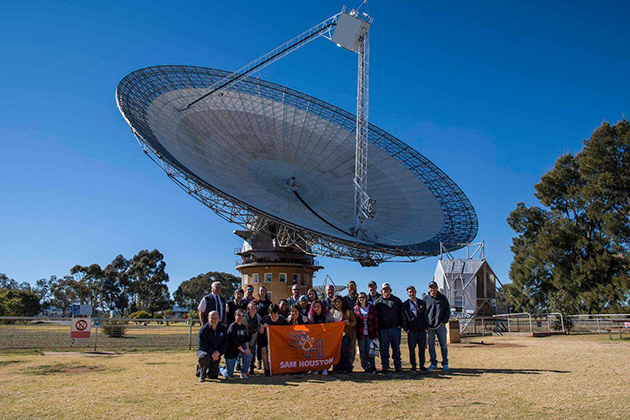 |
| The BLAsT class poses at the Dish with Fantastic Aussie Tours bus driver, Jon. —Photo by Samuel I. Beard, Jr. |
They were able to hike in the Blue Mountains area of Australia and visit the Three Sisters ancient rock formation in the Blue Mountains at Echo Point.
“We visited a 64-meter radio telescope, which has huge historical significance,” James said. “They got a three-hour experience at that facility from someone who knows an insane amount about it. We heard about how astronomy led to the development of Wi-Fi from the people who actually invented Wi-Fi, so these are the kinds of things that you can’t get in this classroom here.”
Each of the students shared their experiences during the trip through blog posts. You can read their stories below.
Arriving In Australia, by Zoe Pappas and Jacob Ackman
Sleep-deprived and disoriented after completely bypassing an entire calendar day, we rushed to the trains to catch a ride out to Katoomba where we would be staying for the next week. And after over 30 hours of traveling, we made it to our first stop.
One of the first things that we notice while on the two-hour train ride was that the sun was not hanging out in the southern sky, which we are used to in the United States. Traveling from the northern to southern hemisphere we went from being in summer to the winter, resulting in more than just a temperature difference. We went from having 14 hours of daylight to just 10 and a half hours. While this is something that we experience gradually when transitioning from the summer to winter, experiencing this change overnight has put the difference in daylight hours into perspective for several of us.
The first night we took a short walk to Echo Point, a scenic overlook in Katoomba, where we observed some of the constellations, asterisms and celestial objects that we cannot see from the northern hemisphere. It was amazingly dark. For people who have not been here it is difficult to express just how dark it gets, even just 100 kilometers outside Sydney. The Milky Way stretches across the night sky. The Small Magellenic Cloud was easily visible and the Southern Cross is a brilliant jewel-tipped kite. Even the motions of the stars are different, as we are learning in class, and seeing for ourselves outside, something impossible to do at home.
Homemade Telescopes And Sketching, by Aliyah Mohammed and Cristal Hernandez
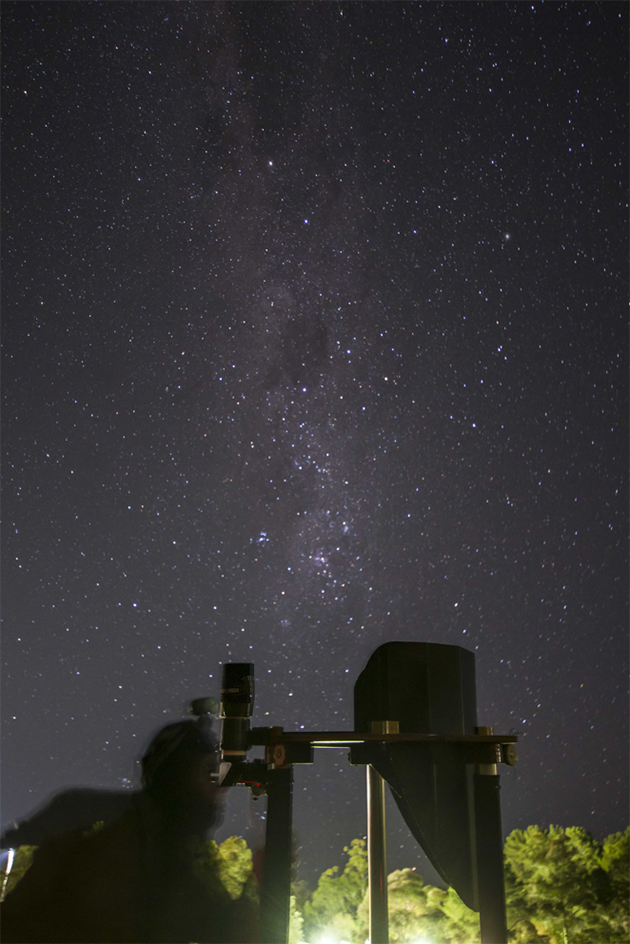 |
| Ben Blume looks through Alex Massey's telescope as the Milky Way arcs overhead. —Photo by Samuel I. Beard, Jr. |
The BLAsT class welcomed Alex Massey as the first guest speaker. Massey is an artist specializing in astronomical sketching. However, he is not your typical artist. He utilizes tools such as makeup brushes, chalk and pencils to recreate beautiful celestial phenomenon. He started the night off by demonstrating the process of creating these images. Although he finds inspiration from photos, he enjoys using his handmade telescope to make his images as realistic as possible.
Massey started our astronomical journey off right with his friendly personality, jokes and vast knowledge. It was a privilege to get to know him and the students wish him all the best.
Aboriginal Sky Stories, by Benjamin Blume and Remy Shelton
The Scottish-born Australian David McKinnon is a retired professor and astronomer who came and talked to us about Aboriginal sky stories and his work sharing astronomy with schoolchildren.
We were honored to be the first group to hear the story of the Seven Sisters, what we call the Pleiades, from Senior Elder of the Wiradyuri Nation, Auntie Gloria Rogers, who is said to be related to the third sister. The Wiradyuri story of Pleiades is that the stars began as seven beautiful emu sisters who were being pursued by the dingo men, so the sisters asked to be taken into the sky so they couldn't be reached. The dingo men went into the sky, becoming Orion, always pursuing the emu sisters.
Weighing Black Holes With Lasers, by Maya Fitch and Sarah Deitrich
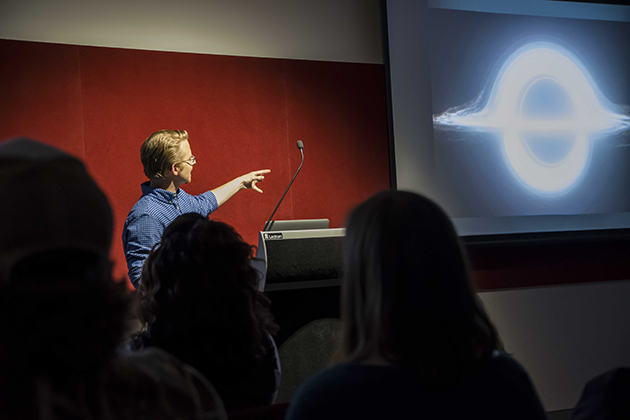 |
| Richard McDermid uses a still from the movie "Interstellar" to help students understand the world of black holes. —Photo by Samuel I. Beard, Jr. |
We went to Macquarie University to hear a presentation by Richard McDermid, a lecturer and researcher at Macquarie University. Just the title sounded exciting: “Lighting the Dark—Weighing Supermassive Black Holes with Lasers.”
So how do you weigh a thing you can't see? First you look at what it's doing to the things around it. In the case of the Galactic center, there are stars that appear to be orbiting NOTHING! But that 'nothing' turns out to be a black hole with four million times the mass of the Sun, and those orbiting stars are just following the same rules that we've been learning about in class.
Looking into the center of the Milky Way is tricky. There's lots of dust in the way, and if that weren't bad enough, Earth's atmosphere causes everything to twinkle. Observatories, with the help of adaptive optics, are able to get rid of the 'twinkling' effect our atmosphere causes on stars. Basically, the distortion of the light is canceled out by constantly changing the shape of the mirror. Once the twinkling effect is removed, we are able to better gather information of the stars.
The whole talk was mindboggling. It's amazing to see the lengths astronomers go to understand our universe. and we would like to sincerely thank McDermid for sharing his time and knowledge.
Riding Gravitational Waves, by Abigail Stephens and Keegan Engelking
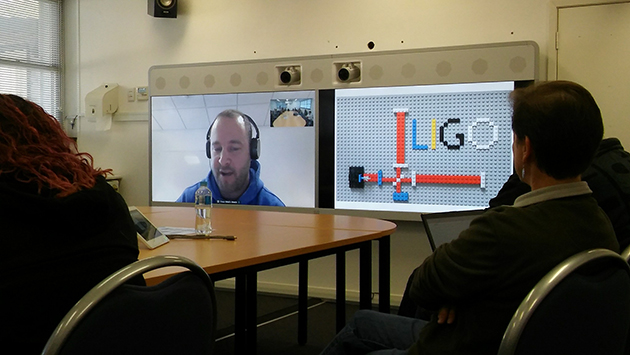 |
| Paul Lasky lectures on Lego LIGO laser light. Apparently, to make a workable LIGO detector that would compress/stretch by a single Lego block, you would need to make its arms long enough to reach from here to the galactic center. —Photo by Scott Miller |
The individual trapped in the screen to the left is Paul Lasky. Although I stated trapped, he voluntarily gave up his time in Melbourne to videoconference with our BLAsT class at the CSIRO Astronomy and Space Sciences campus in Marsfield, NSW. This Monash University researcher is a member of the Australian Centre for Gravitational Wave Research, OzGrav, the LIGO Scientific Collaboration, and the Parkes Pulsar Timing Array. Today we traveled back in time to 1915 when Einstein presented his theory of gravity to the Prussian Academy, neatly explaining the orbit of Mercury and revolutionizing the way we think about gravity. Einstein presented what looked like a pretty simple field equation which solved some of the problems in the way gravity behaved and that couldn’t be fit by Newton’s theory. Einstein’s weird idea was supported in 1919 by Sir Arthur Eddington and colleagues, who observed bending starlight during the solar eclipse. In fact, this is something that our group is HOPING to witness in Casper, Wyoming, during the upcoming total eclipse.
Now we traveled forward in time, and Lasky told us that without this equation we would not have advancements such as GPS, understanding neutron stars, and the discovery of black holes.
Black holes were really where Lasky’s story took off. Like ducks swimming across a pond, black holes—and all masses, for that matter—create ripples in space time. These ripples can even be detected when something extreme happens, like two merging black holes. In fact, this is what our gravitational wave ‘telescopes’ first detected in September 2015. The black holes in question were orbiting each other at about half the speed of light, (really freaking fast!). They merged within a fraction of a second, sending out these ripples we call gravitational waves. These black holes were about 30 times the size of our sun, and their merger released more energy than the rest of the universe combined during that fraction of a second. Seems easy to detect, right?
Wrong.
Meet LIGO! These two facilities detected the merging of the two black holes by using a highly sensitive laser. LIGO shoots a laser into a mirror down two “arms,” which then reflect the light back and scientists can measure how well the light waves match up after the return trip. When a gravitational wave rolls through, this stretches and compresses space time, so one arm’s laser will come back a bit earlier or later compared to the other. How much earlier or later? Well, the wave we “felt” changed the size of LIGO’s four-km-long detection arms by one-thousandth the width of a proton… at which point the whole class went, “Whaa!?” This is due in part to the billion or so light years of distance between us and the merging black holes, and also to the fact that gravitational waves are so week. And since we can’t feel or measure this on our own, we need a large, highly sensitive machine like LIGO. With this technology, we can ride the wave to a future with better understanding of our universe. Cowabunga Dude!
Revisiting Einstein, by Jacob Ackman and Remy Shelton
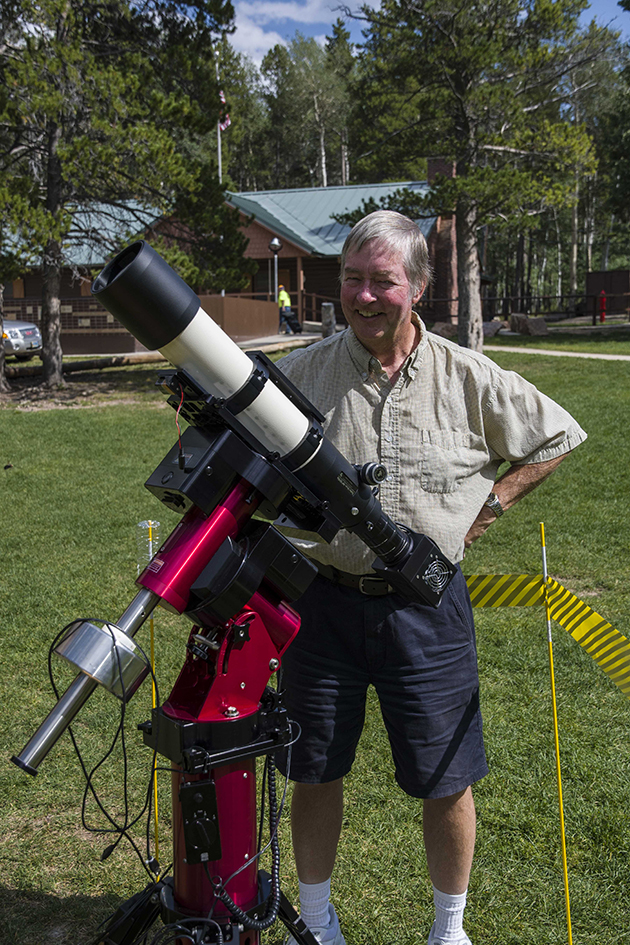 |
| Don Bruns poses next to his gear just 20 hours before totality. —Photo by Samuel I. Beard. Jr. |
At our camp, we heard from Don Bruns, a retired physicist who is taking it upon himself to finish an experiment that has not been successfully reproduced since 1919: Observing the bending of starlight during a total eclipse.
As we’d learned earlier in this class, gravity does weird things to light. Black holes warp space so much that you can literally see what’s behind them. But even with less massive objects, Einstein’s theory of relativity predicts that the starlight will bend as it passes by, making the stars look like they’re out of place. In 1919, an expedition led by Sir Arthur Eddington set out to test Einstein’s theory, which was competing against Newton’s law of gravitation. Although both theories suggested that the stars near the Sun would appear out of place, Newton’s predicted deflection was only half Einstein’s, which predicted that stars near the Sun would appear to be about 1.75 arc seconds out of place. This phenomenon would only be able to be observed during a total solar eclipse due to the sun washing out the light from other stars. This first experiment was successful, but Eddington observed only a handful of stars. Still, it was enough data to show that Einstein was right, and this verification is what launched Einstein to fame.
But all this could change. Bruns wants to successfully recreate this experiment so that the work of all the astronomers before him could be completed and their work not be in vain. He selected an 8000-foot mountaintop near Casper, Wyoming to take his data to maximize the chance of clear skies and minimize the atmospheric effects.
He has done plenty of dry runs with this equipment so that everything runs smoothly during totality. In March 2017, he took a calibration test of stars, expecting a straight-line result, as there is no deflection. He got the result expected within 0.03 arc seconds, a phenomenal improvement on previous observations. Moreover, there are two fairly bright stars that will appear very close to the Sun during the eclipse, and they should appear to move all of 2.2 arcseconds. This result from these two stars alone will be enough to prove Einstein right because they are so close to the sun that it will move more than one pixel across his image. Within an hour he will know if the images are good enough to get the results he’s hoping for, but it will still take him several weeks to process the images to get the final results which will then be published about 6 months after that, so keep on the lookout. The BLAsT class wishes Bruns the best of luck in his experiment, and we look forward to seeing his results!
The Total Eclipse, by Maya Fitch and Rayne Horton
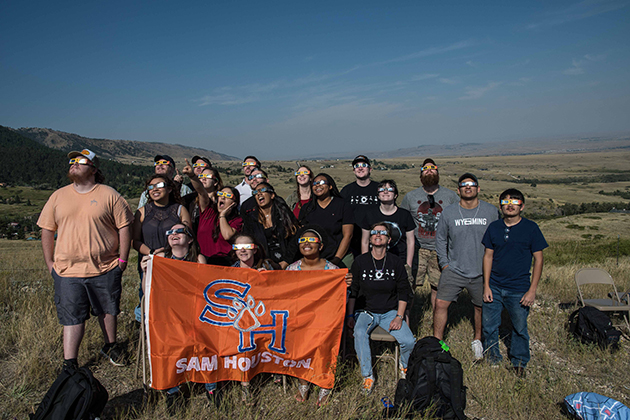 |
| The BLAsT class watches the eclipse just after first contact. —Photo by Samuel I. Beard, Jr. |
Our class along with millions of other individuals witnessed the total solar eclipse. There are no words to describe how incredible the experience was, but if we had to put the eclipse into words a few would be: amazing, astonishing, unbelievable, out-of-this world (pun intended), and magical. As we said before, there are no true words to define the event we saw.
We had clear skies and great binoculars to see this magnificent event. As we drove down the mountain to find the perfect spot to see the shadow and eclipse we could already see a line of cars ready for the moon to go across the sun. Although we had hours to spare it felt as if I was only waiting for the first contact for about 30 minutes when it was actually two hours. The totality felt even faster! A couple minutes before the totality, you could slowly see the light starting to get darker. A daytime sunset around every horizon was a sight of a lifetime.
As the week progressed, Casper, Wyoming grew in population to more than five its usual 60,000. To witness the eclipse is to witness greatness. In fact, the momentum was built up so much the moment the clock struck 10:22 a.m. everyone began screaming and then realized we couldn’t see the first contact between the moon and sun immediately. Hope was not lost; we anxiously waited and moments later saw an olive/eyeball shape appear through our solar lenses. Then, as the moon slowly moved across, the sun looked like a PacMan with a wide-open mouth, and then lastly like a crescent moon.
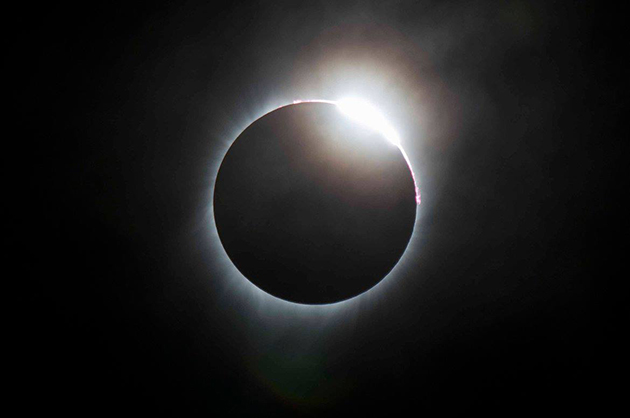 |
| The diamond ring effect. —Photo by Samuel I. Beard, Jr. |
The first diamond ring occurred and we knew we only had a short amount of time before we would be in even more awe of the total eclipse. All the websites said that the totality was to last about two minutes according to NASA. But NASA is a big fat liar, because there is no way that eclipse lasted two minutes. It felt more like thirty seconds, and then the second diamond ring occurred. It was chaotic looking back and forth between the eclipse, shadow, and the jubilation around us.
The sights we saw were to die for, but if that weren’t enough, during the second “diamond ring,” something spectacular happened. The instant totality ended, one of the students in our class wasted no time in proposing to his girlfriend (also a BLAsT Class student.) It was the biggest diamond ring anyone could ask for – a romance between the Sun and Moon. Talk about perfect timing for your engagement! Of course, she said yes!
Tour, Planetary Nebulae And The No-Worries Shelf, by Sandy Ackman and Benjamin Blume
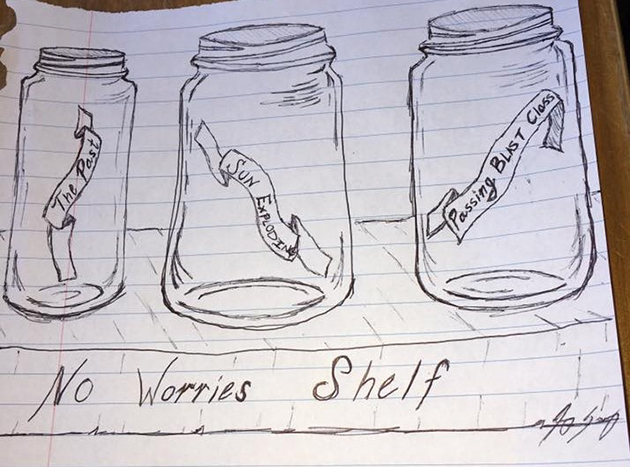 |
| Inspired by Stacy Palen, who said that once she realized the sun wasn't going to to explode, she could put that fear in a jar and place it on her "no-worries shelf." Jamz Engelking created their own no worries shelf. |
While we were staying at the Allen H. Stewart Lions Camp in Casper, Wyoming, we heard from James’ doppelganger, Stacy Palen who specializes in planetary nebulae. These are the shells ejected from low-mass dying stars, something the Sun will become in about five billion years.
Originally astronomers believed that planetary nebulae “poofed” into spherical shells or bubbles. After all, they appeared to us as circles on Earth, so it seemed only possible that all planetary nebulae were round because a star is round. WRONG!!! A friend of Palen’s finally convinced the Hubble Space Telescope time allocation committee to let them look at some planetary nebulae and they found that planetary nebulae come in various shapes, sizes, colors, and patterns. They are just truly phenomenal to look at! Now instead of being boring spheres, planetary nebulae have lots of interesting shapes, but they still always had some kind of symmetry to them – spherical, bipolar, or S type symmetry.
So why should we even care about planetary nebulae? Well for starters, our Sun will poof and turn into a planetary nebulae…eventually…we’ve got about another few billion years left so we can hold off on worrying about that for now. In fact, there’s a whole lot of jars we can put on our “no-worries shelf,” according to Palen. So, we did.
But because our Sun and stars like our Sun will live for billions of years, and because this phase in their lives is so comparatively short, they deserve to be noticed. They could tell us something about cosmic distances. Also, taking notice of planetary nebulae is pretty much like taking notice of yourself since 90 percent of the carbon in our body was created in these kinds of stars through their death. And that is one of the coolest connections in the universe.
The BLAsT Class Learns To ‘Move It Like Moana,’ by David Collicott and Gaby Loredo
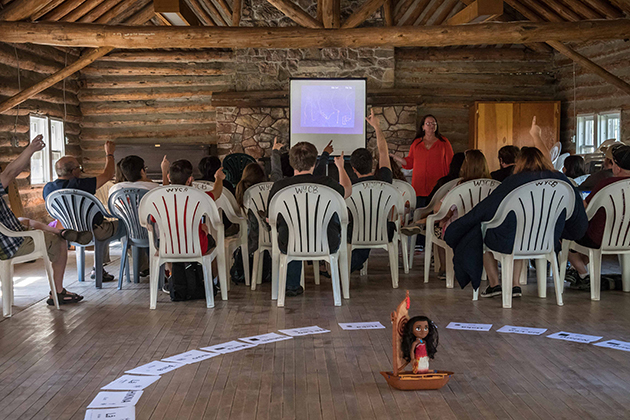 |
| Moana waits in her boat while the BLAsT class learns how to point out and sing the four main constellations in the sky. —Photo by Samuel I. Beard, Jr. |
Astronomy in “Moana”? That’s what we thought. But Stephanie Slater gave us a lesson on the movie’s traditional Polynesian water navigation and its relation to the stars. Through the stars rise and set times, their altitude, and their relation to the stars around them, the ancient navigators were able to tell their location with great accuracy and purposely move from tiny island to tiny island in the vast Pacific Ocean.
Slater did an amazing job engaging us by combining her experience with Polynesian celestial navigation with the Disney movie, Moana. Her presentation was full of information, but it was also very personal. Slater is very passionate about everything she has done in her life, from working to increase diversity in STEM fields to being a K12 teacher to her 22-acre sweet potato farm in Hawaii! An MIT graduate, she has spent years in Hawaii building an extremely close relationship with Polynesian astronomers and cultural figures who have cultivated a great admiration for different Polynesian cultures. And in only an afternoon, she shared what she knew with us.
The most important lesson she taught us is that there are three things that a navigator needs to know before becoming a navigator. The first one is piko i meaning "being able to see the heavens." The second is piko o meaning "knowing how to see my place in the world.” The last one is piko a meaning "understanding how the world changes because of my actions."
Just like Maui says in “Moana,” it is true that real navigators can only tell where they’re going by knowing where they’ve been. When the navigators of old went looking for other islands, they didn’t sleep on the trip. And the trips could last about a month! The reason they can't sleep is because they always have to know how the sky has appeared for the whole journey. Once you lose your bearings, you're lost! And in the ocean, being lost most likely means you’re dead.
The Polynesian navigators divided stars among four constellations that each stretched all the way across the sky from north to south. He Ka, the first constellation, represented what seemed to be a little dinky scoop. Of all things, why would they choose a little dinky scoop as their constellation? Well, this scoop is used to bail the water out of a boat. If you’re out at sea, you definitely want to be able to do that! It just goes to show that even the littlest thing in our lives can be incredibly important and essential to our lives. In the spring, He Iwi comes out and it is the backbone of a gecko. He Makau, the third constellation, is a fish with a hook. You know that hook if you know our constellations. It’s Scorpius. And it’s also the magic fish hook that the demigod Maui was seeking in the movie! (By the way, if you haven't noticed, all of their constellations are named after things related to living on the ocean.) The last constellation, He Lupe, represents the social skills to navigate.
Once we had all the main constellations shown to us and their significance explained, we had to point them out and sing them for Slater. And if we didn’t get it right or if we didn’t show enough spirit, we had to keep going. That’s because a navigator has to know the sky!
Seeing Double With Graeme Jenkinson, by Zoe Pappas and Jeffrey Berg
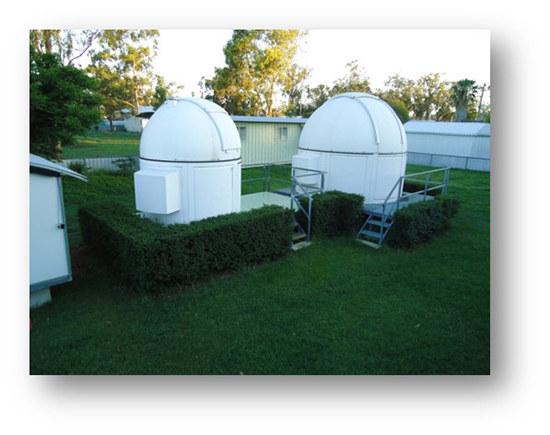 |
| Graeme Jenkinson's backyard observatory near Brisbane, Queensland. —Photo by Graeme Jenkinson |
We had the honor of hosting Graeme Jenkinson, who was visiting Wyoming all the way from Australia, for a presentation about observing double stars on a tight time budget.
He explained that double stars are a great way to do some observing that will provide useful data, particularly if you lack a significant amount of time. Double stars also do not require pristine skies to observe, which makes this easier for Jenkinson to observe even from his backyard in Queensland.
Observing binary stars helps astronomers determine the total mass of a binary system, and then they can look closer at the motions to figure out each star’s mass. Jenkinson told us about a star he had observed that had last been studied by William Herschel in the 1800s, so he was able to update the data on it.
Jenkinson plans his observations by first going to the Washington Double Star Catalogue (http://www.usno.navy.mil/USNO/astrometry/optical-IR-prod/wds/WDS).
He looks for objects that haven’t been updated in a while—apparently sometimes quite a long while—and then uses his relatively modest equipment to take several images over several nights. Then he combines his images and, after a fair bit of analysis, publishes the information that he has spent months working on.
Most of us didn’t realize that amateur astronomers made important contributions to the field, but people like Jenkinson, who observe for the love of the subject, showed us that even part-time astronomers can help us understand this incredible universe.
Earth’s Space Weather Forecast, by Abby Stephens and Keegan Engelking
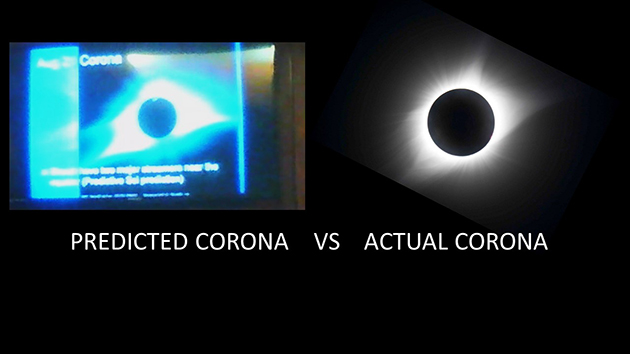 |
| A shot of one of Patricia Reiff's slides showing the predicted shape and extent of the solar corona and a photo of the corona during totality. —Photo by Renee James and Samuel I. Beard, Jr. |
What is the first thing you think of when someone says space weather? Is it raining storms with zero gravity with rain drops going every direction? Or is it flashing interstellar clouds with space lightning? Although it is neat to daydream about space weather being this way, the reality is very different from these depictions. Patricia Reiff, a professor from Rice University specializing in space plasma and magnetospheric physics, took us on a journey to understand space weather.
Space weather basically happens because what happens on the Sun doesn’t stay on the Sun. Sometimes it will affect Earth’s environment. The Sun “burps” (without excusing itself) and sends plasma, energetic charged particles, towards Earth. Fortunately, we are spared the destructive nature of the space environment by Earth’s magnetic field.
Professor Reiff also told us about the MMS, the Magnetospheric MultiScale mission, a suite of four spaceships launched by NASA in March 2015. Designed to help us better understand how Earth’s magnetic field responds to space weather, and orbiting closer to each other than any other set of spacecraft in history, this mission brings in more data than we could imagine. Through these data we are learning amazing things about a subject most of us in the BLAsT class never even knew existed. Needless to say, Reiff was incredibly knowledgeable, and we gained a new appreciation for Earth’s magnetic field and how it plays with particles from the Sun.
But that’s not all! Reiff is also an eclipse chaser! She has traveled to see seventeen total eclipses. She tried to describe how amazing it was going to be when we got to experience totality, but her words and videos and obvious excitement about it still didn’t convey a fraction of what we felt on Aug. 21. What is cool to see in hindsight, though, is how close scientists came to predicting what it would look like. Not just the totality (darkness, obviously), but the shape of the hot, luminous outer layers of the Sun, or the corona. In Reiff’s line of work, understanding the Sun is part of the job description, and solar scientists had predicted the basic shape and extent of the corona based on their knowledge of the Sun’s activity. We were amazed to see just how close they were!
Read more about the trip by reading blog posts at http://cs.astronomy.com/asy/b/astronomy/default.aspx. Anything that has “Guest blog” and was posted by Nicole Kiefert indicates the BLAsT class stories.
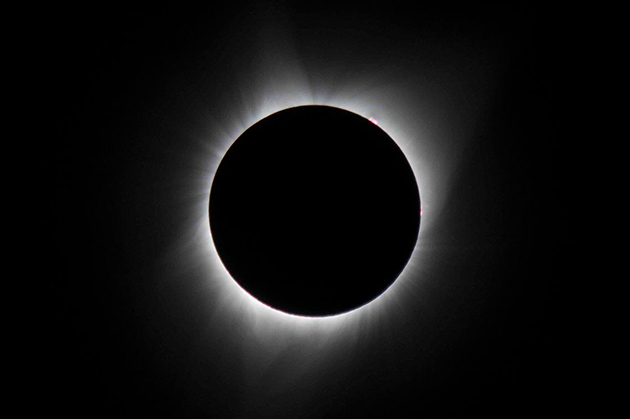
- END -
This page maintained by SHSU's Communications Office:
Director of Content Communications: Emily Binetti
Asst. Director Content & Social Media: Emilee White
Communications Manager: Mikah Boyd
Telephone: 936.294.1837
Communications Specialist: Campbell Atkins
Telephone: 936.294.2638
